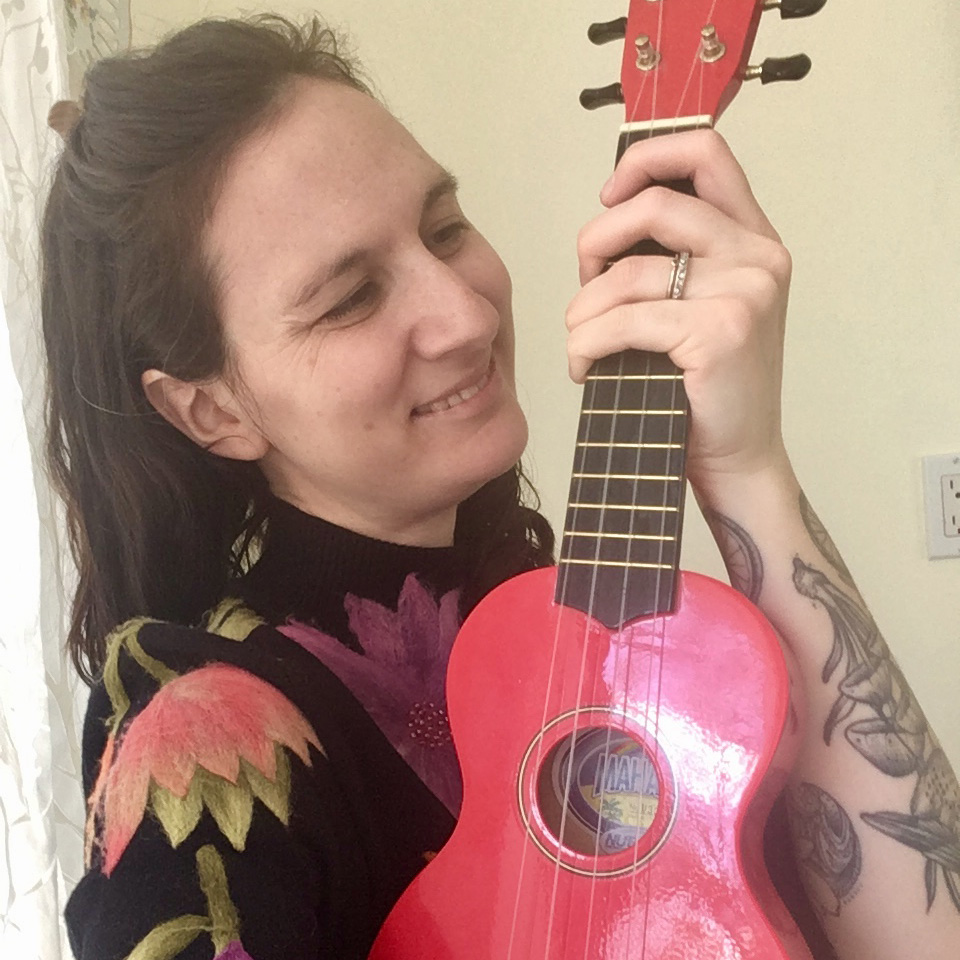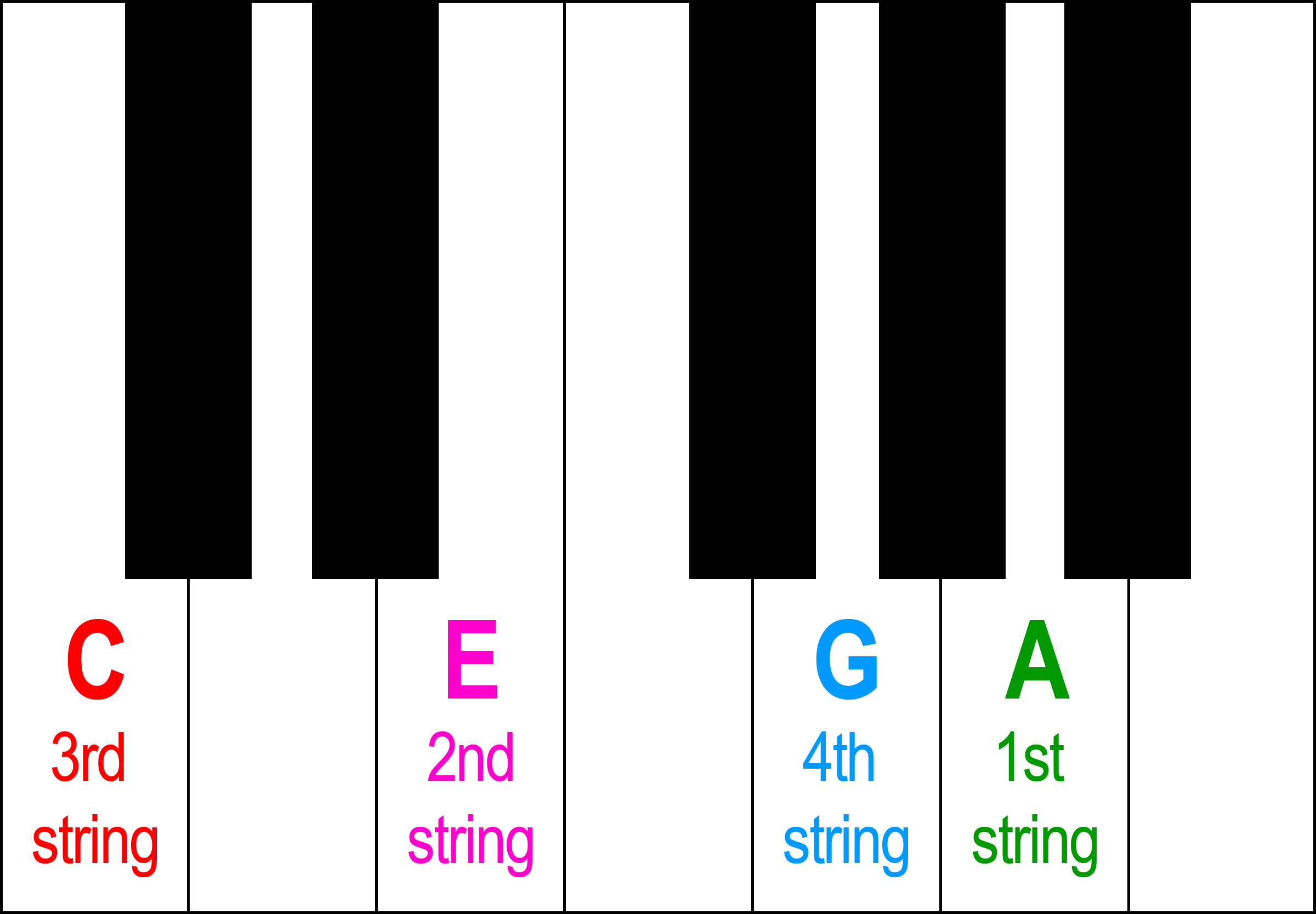The number one way to sound better as a beginner ukulele player is to tune your ukulele.
Your audience will thank you for it and you’ll be inspired and even surprised by the beautiful sound you create!
A lot of new ukulele players don’t realize the ukulele has to be tuned frequently to maintain the best sound. Relatively cheap ukuleles require more frequent tuning whereas higher-end ukuleles often hold their tuning for longer.
As a rule of thumb, check your ukulele tuning every 15 minutes.
Now this might sound like a lot of tuning at first but with this lesson you’ll be a pro at tuning your ukulele quickly in no time at all.

In this lesson, learn how to tune your ukulele quickly and easily, as well as:
- How to tune your ukulele quickly with a chromatic tuner
- Discover what “standard ukulele tuning” is
- How to tune your ukulele by ear
- How to tune if you’re a “left-handed” ukulele player
- Explore alternate ukulele tunings like “low G” and baritone tuning
- What strings to use (and how to know when to change your ukulele strings)
Let’s take a look.
How to Tune Your Ukulele the Fastest Way
In this video lesson, learn how to tune your ukulele.
This tuning method works for almost any ukulele including soprano, concert and tenor ukuleles.
The fastest and easiest way to tune is to use a chromatic tuner, which I show you how to use in the video above.
A chromatic tuner is a device that detects the pitch of a note as you pluck a string of the ukulele. With the aid of a chromatic tuner, you can quickly identify if you are sharp or flat (that is to say “too high” or “too low” in pitch) relative to the desired note. I prefer the Snark SN-6 ukulele tuner that clips on to the headstock of your ukulele, although there are a wide variety of “chromatic tuner” apps you can download for your smartphone.
By the way, did you enjoy that video lesson? You can learn to play your first songs with me on ukulele in the FREE 45-page ukulele lesson book Your First Ukulele Lesson and Then Some delivered right to your email inbox.
To get a free copy of the digital lesson book delivered to your inbox, just enter your email below:
Yes! I want the free ukulele lesson book Your First Ukulele Lesson and Then Some.
Please note: I take your privacy very seriously. I promise never to spam you or distribute your email to a third party.

“Thank you so much for these wonderful lessons. I have been inseparable from my (new to me) ukulele and am beyond thrilled that these lessons are allowing me to learn how to properly play it. I can tell that this relationship with my ukulele is going to be a lifelong bond. I can’t wait until I am experienced enough to play and sing songs to my 3 children. They have, thankfully, been enjoying the (nearly nonstop) strumming and lovely sounds being produced by my beloved new little friend. And that is thanks to you.”
– Lydia C., Student
Tune to These Notes in Standard “Reentrant” Ukulele Tuning
Most soprano, concert, and tenor ukuleles (read more about ukulele sizes here) will be tuned to standard reentrant ukulele tuning. The following figure shows a right-handed ukulele tuned to standard reentrant tuning.

As you can see, the bottom string or first string is tuned to an A. The second string is tuned to an E. The third string is tuned to a C, and the fourth string or top string of the ukulele is tuned to a G.
Please note the above figure is a “top down” perspective of the ukulele, as if you were supporting it in your lap, ready to play. In this way, the bottom line of the figure represents the top string of the ukulele; likewise, the top line represents the bottom string of the ukulele. From the top to bottom string, see how a ukulele is tuned on the music staff.

And see how a ukulele is tuned on the piano keys.

Notice that the top g-string (4th string) is tuned higher than the middle two strings – the top gstring is tuned to a G-note above middle C on a piano. This is why it is called reentrant tuning. The lowercase “g” is used to indicate that the G-note is above middle C.
Reentant Tuning vs. Linear Tuning (High G vs. Low G)
If you’re used to playing guitar, it might seem odd that there is a high g-string. In standard reentrant tuning, the pitch of the strings on the ukulele don’t go from lowest to highest. This tuning is part of what makes the ukulele have that bright and charming sound. Reentrant tuning gives you the most even tone because the strings are kept in a smaller range.
However, some ukulele players prefer to tune the g-string down an octave to play in low G ukulele tuning (learn how to tune to low G tuning), sometimes referred to as linear tuning because the strings are arranged from lowest to highest. Not only do you get a broader range with low G tuning but some might consider the sound to be a more full and resonant.
Warning: Please note if you want to tune your ukulele to low G you will need a special set of low G ukulele strings based on your size of ukulele. Do not try to tune a high-g ukulele string down an octave because it will not sound pleasing!
How to Tune Your Ukulele By Ear
What if you don’t have a chromatic tuner or a piano nearby to tune your ukulele?
If this is the case, order a chromatic tuner as soon as possible or download a chromatic tuner app on your smartphone. The sooner you do this the easier it is to tune!
Still though, learning how to tune your ukulele by ear is a handy skill and is a great exercise in training your ear to detect differences in pitch.
First, listen to each of the ukulele pitches.
g-string (4th string)
C-string (3rd string)
E-string (2nd string)
A-string (1st string)
To tune your ukulele by ear, listen to the pitches as a point of reference for tuning your ukulele.
Then, play the top g-string audio. As the sound is playing, hum the note and get it in your head. Do this before plucking any strings on your ukulele. Once you’re certain you’ve heard the pitch, pluck the top string, or the g-string, on your ukulele. Now, get this pitch in your head.
If the pitch of the plucked string is higher than the pitch of the sound playing on the tuner, that means the string on your ukulele is sharp.
If the pitch of the plucked string is lower than the pitch of the sound playing on the tuner, that means the strings on your ukulele is flat.
As both sounds are ringing, turn your tuning pegs on your ukulele to match the two pitches. When the pitches aren’t matching, at the initial attack of the two sounds, you’ll hear almost a warbly sound between the two like this:
When the pitches are matching, the warbly sound will be gone and the two sounds will ring smoother against each other like this:
These are the essentials to tuning by ear.
Remember, the most accurate and easiest way to tune your ukulele is to use a chromatic tuner.
How to Tune Your Ukulele if You’re “Left-Handed”
I’m a dominant left-hander, meaning, I write with my left hand and using my left hand comes most naturally to me, so let me be the first to say I understand where you’re coming from!
That said, if you’re a leftie who is just learning to play ukulele then I recommend you tune your strings as shown above using your left hand to fret chords and right hand to strum. This will allow you to follow along with me.
Equal use of your dominant and non-dominant hand is required to play ukulele, which is why I don’t recommend playing “left-handed”. Learning to play ukulele is going to feel awkward at first, so embrace it and press through it. You can do this!
The only exception I’d make to this is if you’re missing a finger or have a physical impairment that restricts the movement of one of your hands (such as arthritis). If that is the case, then, you will need to re-string your strings in the opposite order and tune accordingly. Do not flip the ukulele around or play it upside down. It will be easier to play “left-handed” if you re-string the ukulele in the inverse.
You’ll thank me later for pushing through the awkwardness and learning to play ukulele where you use your left hand to fret the chords and right hand to strum.
How to Tune Your Ukulele to Alternate Tunings
Here are some other ukulele tunings used by different ukulele players.
Baritone Ukulele Tuning (D, G, B, E)
Baritone tuning is used on baritone ukuleles and sometimes even on tenor ukuleles. This ukulele tuning is equivalent to the tuning of the last four strings on a guitar. Sometimes this tuning is referred to “G tuning.”
If you have a baritone ukulele and wish to follow along with my lessons, follow this guide here.
Slack-key Tuning (G, C, E, G)
Popular in Hawaiian music, in slack-key tuning, if you just strum the strings as open strings, you’re strumming a C major chord, which makes this a very open tuning. The top g-string can be tuned either in reentrant or linear tuning, meaning you can either tune it to the “G” note above middle C on a piano or down the octave.
English Tuning (A, D, F#, B)
English tuning, also considered as a “D tuning”, this tuning has the same amount of intervals (the amount of notes between each string) as standard ukulele tuning but every string is tuned up a whole step higher. You’ll want to use an English tuning string set if you wish to tune in this manner. This tuning is popular for soprano ukuleles or banjoleles. Some find this tuning to be a bit sweeter in tone.
Canadian Tuning (low A, D, F#, B)
Canadian tuning is nearly identical to English tuning except you tune the top a-string down an octave. This tuning is popular for concert and tenor ukuleles.
What Strings to Use (and How to Know When to Change Your Ukulele Strings)
As a general rule of thumb, plan to change your ukulele strings every three months or so with regular daily playing.
Old ukulele strings begin to sound duller and not as lively. Strings wear out with playing which is why for the best sound it’s a good idea to change your strings every few months.
A lot of ukulele players wonder what the best ukulele strings are.
You can’t go wrong with Aquila ukulele strings (soprano, concert, tenor), but there are other brands worth trying like Worth, D’Addario, and more.
Every ukulele responds differently to different strings, so I recommend to experiment and have fun with it! See which strings sound best on your ukulele.

